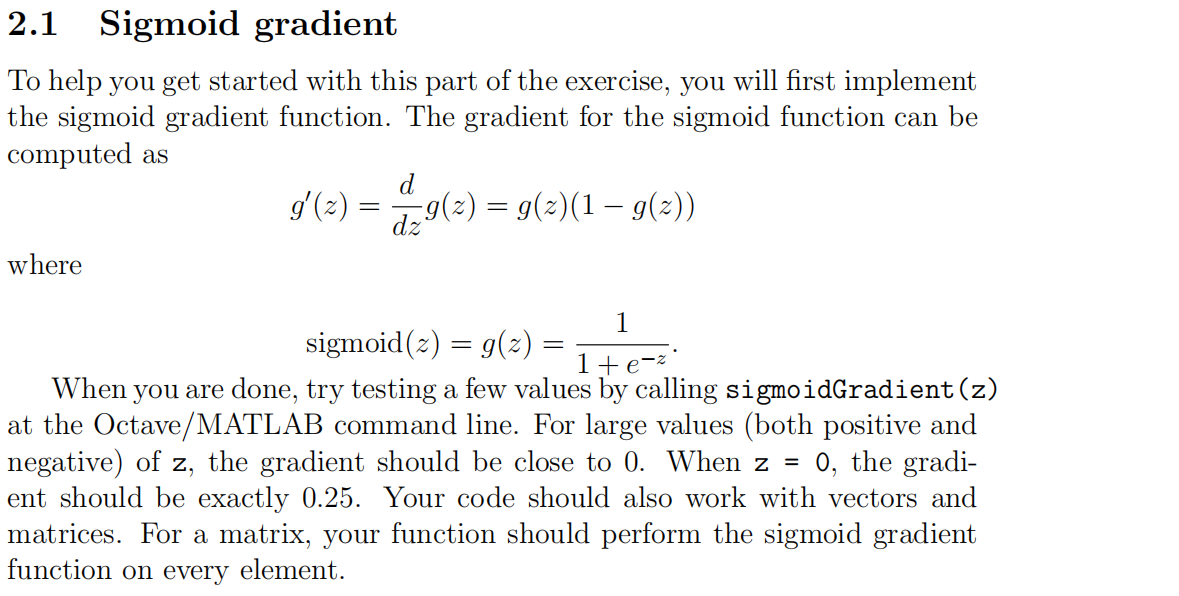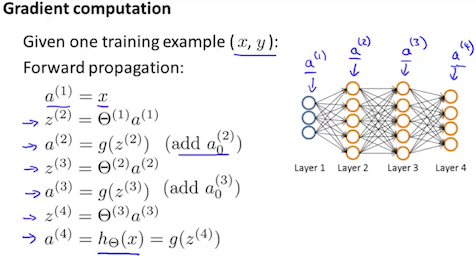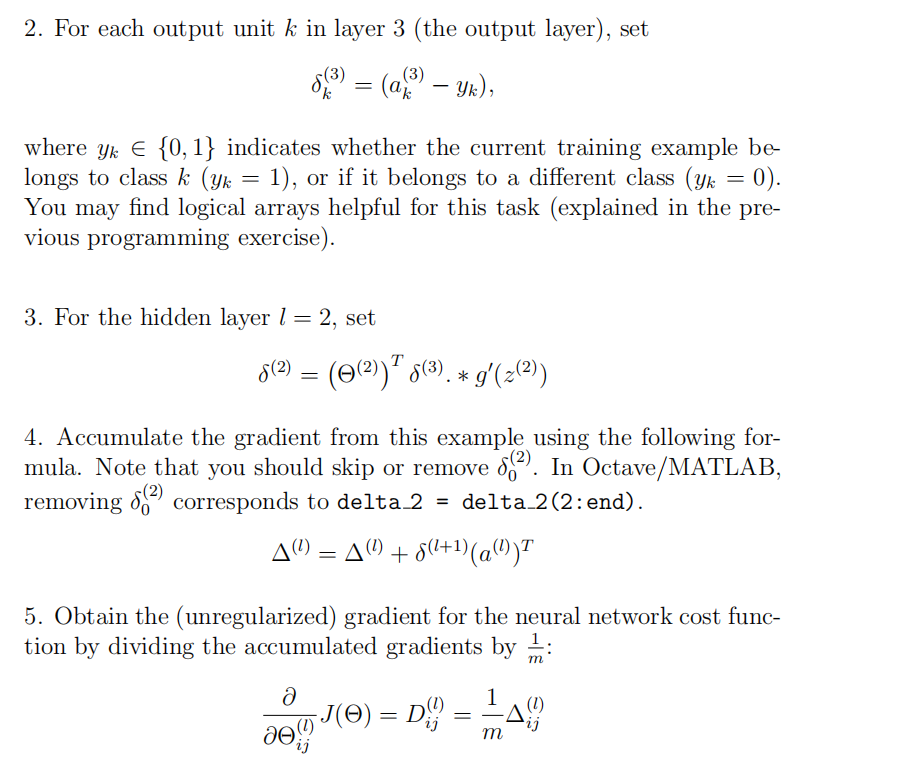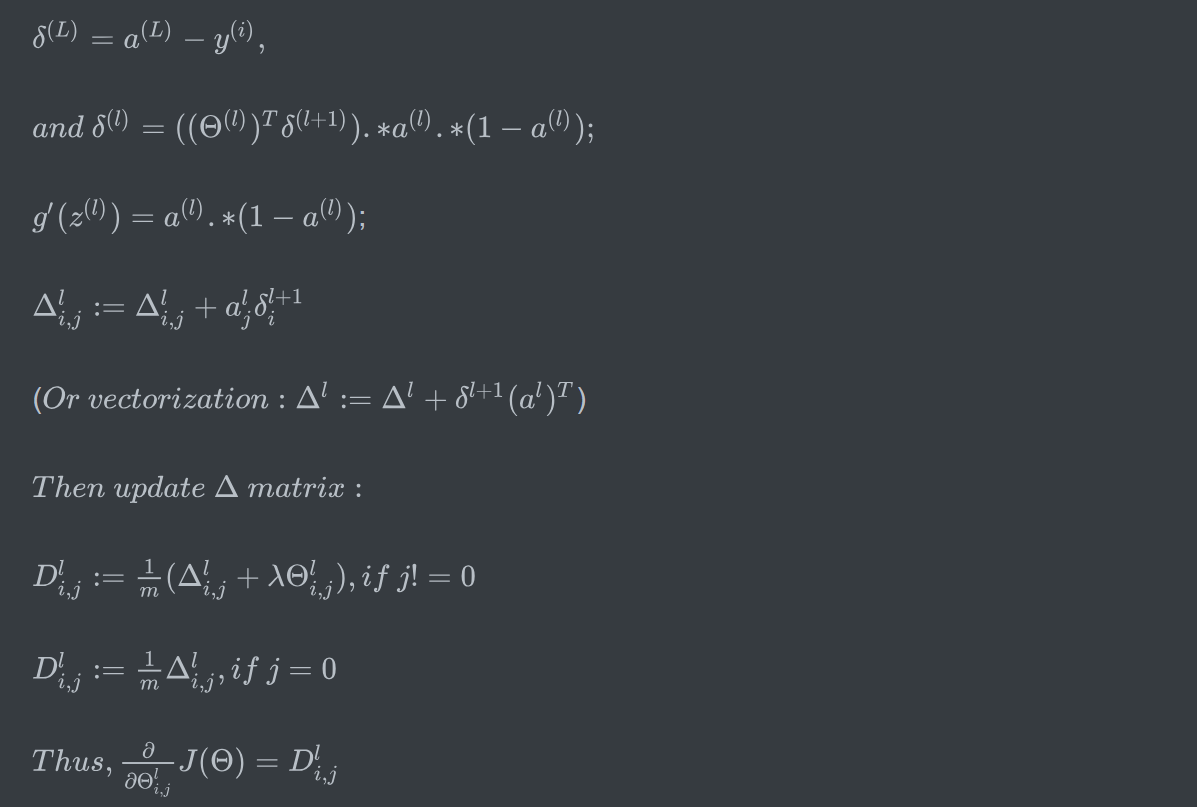Machine learning 第5周编程作业
1.Sigmoid Gradient

function g = sigmoidGradient(z)
%SIGMOIDGRADIENT returns the gradient of the sigmoid function
%evaluated at z
% g = SIGMOIDGRADIENT(z) computes the gradient of the sigmoid function
% evaluated at z. This should work regardless if z is a matrix or a
% vector. In particular, if z is a vector or matrix, you should return
% the gradient for each element. g = zeros(size(z)); % ====================== YOUR CODE HERE ======================
% Instructions: Compute the gradient of the sigmoid function evaluated at
% each value of z (z can be a matrix, vector or scalar). g=sigmoid(z).*(1-sigmoid(z)); % ============================================================= end
2.nnCostFunction
这是一道综合问题;
Ⅰ:计算代价函数J(前向传播)
Ⅱ:BackPropagation
Ⅲ:正则化;





function [J grad] = nnCostFunction(nn_params, ...
input_layer_size, ...
hidden_layer_size, ...
num_labels, ...
X, y, lambda)
%NNCOSTFUNCTION Implements the neural network cost function for a two layer
%neural network which performs classification
% [J grad] = NNCOSTFUNCTON(nn_params, hidden_layer_size, num_labels, ...
% X, y, lambda) computes the cost and gradient of the neural network. The
% parameters for the neural network are "unrolled" into the vector
% nn_params and need to be converted back into the weight matrices.
%
% The returned parameter grad should be a "unrolled" vector of the
% partial derivatives of the neural network.
% % Reshape nn_params back into the parameters Theta1 and Theta2, the weight matrices
% for our 2 layer neural network
Theta1 = reshape(nn_params(1:hidden_layer_size * (input_layer_size + 1)), ...
hidden_layer_size, (input_layer_size + 1)); Theta2 = reshape(nn_params((1 + (hidden_layer_size * (input_layer_size + 1))):end), ...
num_labels, (hidden_layer_size + 1)); % Setup some useful variables
m = size(X, 1); % You need to return the following variables correctly
J = 0;
Theta1_grad = zeros(size(Theta1));
Theta2_grad = zeros(size(Theta2)); % ====================== YOUR CODE HERE ======================
% Instructions: You should complete the code by working through the
% following parts.
%
% Part 1: Feedforward the neural network and return the cost in the
% variable J. After implementing Part 1, you can verify that your
% cost function computation is correct by verifying the cost
% computed in ex4.m
%
% Part 2: Implement the backpropagation algorithm to compute the gradients
% Theta1_grad and Theta2_grad. You should return the partial derivatives of
% the cost function with respect to Theta1 and Theta2 in Theta1_grad and
% Theta2_grad, respectively. After implementing Part 2, you can check
% that your implementation is correct by running checkNNGradients
%
% Note: The vector y passed into the function is a vector of labels
% containing values from 1..K. You need to map this vector into a
% binary vector of 1's and 0's to be used with the neural network
% cost function.
%
% Hint: We recommend implementing backpropagation using a for-loop
% over the training examples if you are implementing it for the
% first time.
%
% Part 3: Implement regularization with the cost function and gradients.
%
% Hint: You can implement this around the code for
% backpropagation. That is, you can compute the gradients for
% the regularization separately and then add them to Theta1_grad
% and Theta2_grad from Part 2.
% X=[ones(m,1) X];
a1=Theta1*X';
z1=[ones(m,1),sigmoid(a1)'];
a2=Theta2*z1';
h=sigmoid(a2); yy=zeros(m,num_labels);
for i=1:m,
yy(i,y(i))=1;
endfor
J=1/m*sum( sum( (-yy).*log(h')-(1-yy).*log(1-h') ) ); J=J+lambda/(2*m)*( sum(sum(Theta1(:,2:end).^2))+sum(sum(Theta2(:,2:end).^2))); for i=1:m,
a1=X(i,:)';
z2=Theta1*a1;
a2=[1;sigmoid(z2)];
z3=Theta2*a2;
a3=sigmoid(z3);
tmpy=yy(i,:);
dlt3=a3-tmpy';
dlt2=(Theta2(:,2:end)'*dlt3.*sigmoidGradient(z2)); Theta1_grad=Theta1_grad+dlt2*a1';
Theta2_grad=Theta2_grad+dlt3*a2';
endfor Theta1_grad=Theta1_grad./m;
Theta2_grad=Theta2_grad./m; Theta1(:,1)=0;
Theta2(:,1)=0; Theta1_grad=Theta1_grad+lambda/m*Theta1;
Theta2_grad=Theta2_grad+lambda/m*Theta2; % ------------------------------------------------------------- % ========================================================================= % Unroll gradients
grad = [Theta1_grad(:) ; Theta2_grad(:)]; end
Machine learning 第5周编程作业的更多相关文章
- Machine learning 第7周编程作业 SVM
1.Gaussian Kernel function sim = gaussianKernel(x1, x2, sigma) %RBFKERNEL returns a radial basis fun ...
- Machine learning第6周编程作业
1.linearRegCostFunction: function [J, grad] = linearRegCostFunction(X, y, theta, lambda) %LINEARREGC ...
- Machine learning 第8周编程作业 K-means and PCA
1.findClosestCentroids function idx = findClosestCentroids(X, centroids) %FINDCLOSESTCENTROIDS compu ...
- Machine learning第四周code 编程作业
1.lrCostFunction: 和第三周的那个一样的: function [J, grad] = lrCostFunction(theta, X, y, lambda) %LRCOSTFUNCTI ...
- 吴恩达深度学习第4课第3周编程作业 + PIL + Python3 + Anaconda环境 + Ubuntu + 导入PIL报错的解决
问题描述: 做吴恩达深度学习第4课第3周编程作业时导入PIL包报错. 我的环境: 已经安装了Tensorflow GPU 版本 Python3 Anaconda 解决办法: 安装pillow模块,而不 ...
- 吴恩达深度学习第2课第2周编程作业 的坑(Optimization Methods)
我python2.7, 做吴恩达深度学习第2课第2周编程作业 Optimization Methods 时有2个坑: 第一坑 需将辅助文件 opt_utils.py 的 nitialize_param ...
- c++ 西安交通大学 mooc 第十三周基础练习&第十三周编程作业
做题记录 风影影,景色明明,淡淡云雾中,小鸟轻灵. c++的文件操作已经好玩起来了,不过掌握好控制结构显得更为重要了. 我这也不做啥题目分析了,直接就题干-代码. 总结--留着自己看 1. 流是指从一 ...
- Machine Learning - 第7周(Support Vector Machines)
SVMs are considered by many to be the most powerful 'black box' learning algorithm, and by posing构建 ...
- Machine Learning - 第6周(Advice for Applying Machine Learning、Machine Learning System Design)
In Week 6, you will be learning about systematically improving your learning algorithm. The videos f ...
随机推荐
- 宽字符、多字节、unicode、utf-8、gbk编码转化
今天遇到一个编码的问题,困惑了我很长时间,所以就简要的的了解了一下常用的编码类型. 我们最常见的是assic编码,它是一种单字节编码,对多容纳256个字符. 我们在编程的时候经常遇到unicode,u ...
- websocket客户端实现
<!DOCTYPE html> <html> <head> <meta charset="utf-8"> <title> ...
- [Laravel] mac下通过 homestead 搭建环境 到运行项目
seven_Android 关注 2017.07.03 21:33* 字数 2240 阅读 3464评论 10喜欢 9 之前学习过一段时间的 Laravel ,换 mac 后一直没空做相关的事情,而且 ...
- 界面设计中如何增强CTA按钮召唤力?
以下内容由Mockplus(摹客)团队翻译整理,仅供学习交流,Mockplus是更快更简单的原型设计工具. 网页和软件应用之类数字产品的有效交互系统一般是由拥有各种任务和功能的小元素构成.而为创建更加 ...
- ADO.net开放式并发
https://docs.microsoft.com/zh-cn/dotnet/framework/data/adonet/optimistic-concurrency 在多用户环境中,有两种用于更新 ...
- express4.x Request对象获得参数方法小谈【原创】
最近看完慕课网 “node.js 建站攻略”后, 对mongodb 操作有了进一步认识, 为了进一步巩固该数据库知识, 于是使用学到的知识搭建一个最简单的mongoDemo. 搭建完成后已放到Gith ...
- 转载VC6.0 子窗口和父窗口
这个是我周一在一家公司做的上机题中的一道,当场没做出来.我当时只跟考官说了设计思路,是带回来查了几本资料书之后才完成的.因为有半个学期没用VC开发了……,最近一直都在实践ASP.NET相关的…… 建立 ...
- 移动端html5页面导航栏悬浮遮挡内容第一行解决办法
参考:https://zhidao.baidu.com/question/1608232105428062147.html 1.设置导航栏div属性position:fixed; .nav-fixed ...
- 个人整理的一些iOS Entitlements
收集了不少Entitlement,当然也肯定有遗漏.有的就是key的字面意思,就不多做解释.不过有的虽然字面意思好理解,不过具体的用处不太清楚,就写的Unknown use.在替换entitlemen ...
- Oracle EBS Model Function Technical
♡.Oracle EBS(ERP)Oracle 是公司名字,这个我估计大家都知道.EBS是E-Business Suite的缩写,简单的说,就是Oracle做的一个企业级的信息化软件或者系统,里面包含 ...
